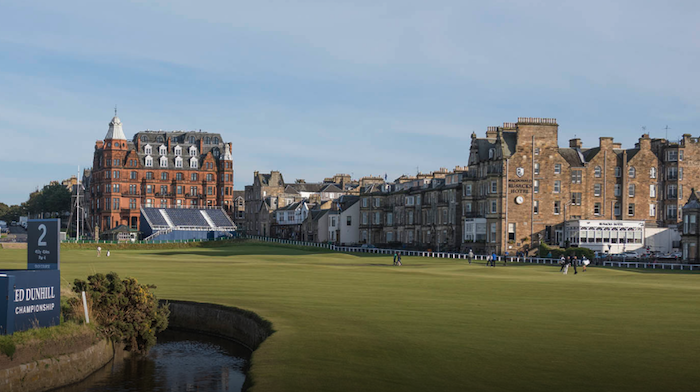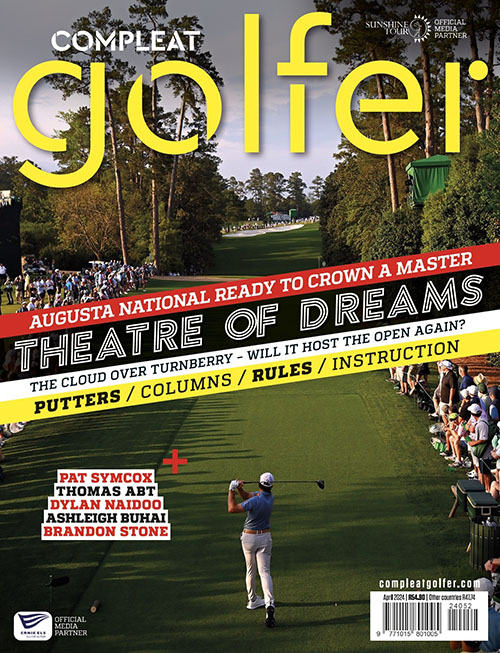The Alfred Dunhill Links is one of the most anticipated events of the year, GRANT WINTER reflects on time spent at the tournament and the lessons he has learnt.
This is my umpteenth visit to the iconic Home of Golf where I’ve witnessed South Africa – Els, Goose and Frost – twice in the late 1990s winning the 16-nation Dunhill Cup (now, since 2001, replaced by the Alfred Dunhill Links Championship), as well as Tiger Woods reigning supreme at the British Opens of 2000 and 2005, and of course Louis Oosthuizen triumphing in the 2010 Open.
In this time I’ve grown to love St Andrews and learn a few secrets about the Old Course, as well as some interesting facts about this ancient university and cathedral town.
Let’s start, appropriately enough, at the first tee. Tens of thousands of ‘pilgrims’ make their way to St Andrews each year to play the Old Course and pay homage to it. But hitting your first drive on golf’s most holy ground can be a harrowing experience. The tee box, you see, is not decently tucked away from prying passers-by. Rather, it’s almost as if you’re in the middle of town. You’ve forked out your exorbitant green fee, you’re dead nervous, your caddie is scornfully checking out your oddball swing and now, it seems, practically every citizen, tourist, student and dog is watching you. It’s a recipe for disaster.
In his book ‘Pilgrims in the Rough’, Michael Tobert reveals that George Bush Senior once spoke before a million people in the early days of Czechoslovakian freedom from communism. It didn’t phase him one bit. But when he first teed it up on the Old Course his knees were knocking violently together, his palms sweating and his pulse racing. Please God, he prayed, help me through this time of trial.
Right from the start in Scotland the game was played crudely on public or common ground, mainly on the east coast’s open stretches along the shore between the beach and the beginning of arable land. This ground was used for general recreation, mending fishing nets and … particularly pertinent here … drying clothes!
Tolbert describes this 19th century scene for us: ‘In 1851 the Rules Committee (the Society of St Andrews Golfers was formed almost 100 years earlier) decided that when a ball was lying on clothes, or within one club’s length of a washing tub, the clothes or the tub could be removed. Now, just picture the scene for a moment. A St Andrews housewife has been hard at her washing all morning and has her sheets nicely pegged out on the fairway, when a grubby old ball lands on them. Not far behind is a golfer who politely asks her whether she would prefer him to hit the ball where it lies – that is by standing on her sheets and ripping into them with his niblick – or whether she would like to remove the washing she spent the last half hour laying out.’
You can imagine that there were some very unhappy women around who demanded something be done. Well, the rule did eventually change but – staid committee men are not to be rushed – it took 37 years before it was approved and in 1888 a ball lying on clothes could be lifted and dropped without penalty!
From pegged out sheets and a President’s prayer to something, shall we say, a little more risque … Miss Granger’s Bosoms, a pair of beautiful and bewitchingly rounded mounds which golfing pilgrims to St Andrews, and participants in this week’s Alfred Dunhill Links Championship, may come across just to the right of the fairway at the par-four 15th. If your drive lands in the lady’s cleavage, you probably won’t be able to reach the green in two. And, in deference to Miss Granger, as Mr Tobert points out, try not take a divot in these charmingly rounded dunes.
From women to drink, and one David (auld Da) Anderson who in the 19th century used to do a lively trade with his mobile refreshment cart. He would park it behind either the fourth or ninth greens, ostensibly to sell ginger beer (the fourth hole to this day is called Ginger Beer). But under the counter, shelves were laden with much stronger beverages that were in high demand from golfers having a bad day and seeking comfort.
And from booze to bunkers. There are plenty of them, cunningly placed to catch the unwary. And most of them have names – three at the ninth called after South Africans and put in by Old Tom Morris during the Boer War. There’s Kruger (after the Boer President) and Mrs Kruger, as well as Cronjé, after the Boer leader who surrendered in 1900 following the relief of Kimberley. Hell Bunker at the 14th is a huge, deep, evil pit. A Bishop of London was so pleased to get out of this hazard at his first attempt that he was reported to have exclaimed: ‘Out of Hell in One!’ To which his playing partner retorted: ‘When you dee, mind and tak’ yer niblick wi’ ye’.’
The notorious Road Hole bunker at the 17th is now known as the ‘Sands of Nakajima’ after the Japanese professional who self-destructed there.
At the par-four 18th don’t be short with your approach. Then you’re in the Valley of Sin, where male and female University of St Andrews students are said to get to know each other a little better once the sun has gone down, and where you can pay heavily if you haven’t been playing clean-living golf.
From golf to ghosts. There are dozens of pubs in St Andrews, many of them full of golfing memorabilia. But, if you ever visit, and you’re on your way home to your hotel or boarding house after a few pints of the fine bitter that is made locally, don’t blame the drink if you think your eyes are deceiving you because you’ve just seen a ghost.
According to Tobert, it could be the phantom coach of Archbishop Sharp, with its four large, black horses that travels the road in silence, it could be the murdered Prior who, on a moonlit night, can be seen looking over the Tower of St Rule, and it could be the Monk trying to lure golfers into the forbidding tunnels and staircases under the ruins of the medieval cathedral.
To make a pilgrimage to St Andrews, and the Old Course in particular, is the dream of millions of golfers from all over the world. Many fairway fanatics save up their hard-earned money for a once-in-a-lifetime visit to this ancient, romantic place, where the game has been played for over 500 years. There are actually nine 18-hole facilities and one nine-holer in the precincts of the relatively small ‘auld toon’ but it’s the holy ground of the Old Course with all its quaintness and rich history that everyone wants to play.
Tackling the Old Course the first time can be both daunting and confusing – as George Bush discovered. So here are a few words of advice (some of them not to be taken too seriously) in the form of ‘Definite Don’ts’ for St Andrews newcomers.
Don’t fall in the Burn! This is no joke. It can happen. When surveying a putt on the first green, which is hard up against the Swilken Burn, be careful not to take one step backwards too many because you might find yourself toppling into the water, as has happened before. In a British Open in the 1920s an over-zealous marshall using a rope to control a line of spectators managed to sweep all of them into the burn.
Avoid the bunkers! There are 112 nasty bunkers on the Old Course, like the aptly-named Grave, Coffins and the aforementioned Hell. And these bunkers can be in the oddest of places, like bang in the middle of the fairway at the par-4 12th hole and completely hidden from view from the tee-box. The ideal drives on the Old Course are often radically left rather than straight. So the key is to plot your way around carefully, as Woods did when winning the 2000 British Open. He didn’t go into a single bunker all week.
Know where the flag is! Some of the Old Course’s greens are extremely large, and simply finding the putting surface is no guarantee of a two-putt. The fifth and 13th holes share one of the biggest greens in the world, big enough for a football pitch. A greenkeeper cutting it with a pedestrian mower will walk 10km and take 90 minutes to complete the task.
Don’t get lost! The Old Course borders at certain points the New Course (not so new since it was founded in 1895), the Jubilee course and the Eden course. If you’re unfamiliar with the territory you can easily lose your way as many of the flattish holes, flanked by gorse and heather, have a similar look about them. A foursome of Americans wandered from the Old Course onto the New Course and played a couple of holes before realising they were lost.
Don’t get stuck at the 19th! If you’re thirsty after the golf it may be of comfort to you to know there are 35 pubs in St Andrews in a relatively small area – more per capita than any place in Britain. Ma Bells, just a four-iron away from the famous Royal & Ancient clubhouse, is where the St Andrews University students hang out. The atmosphere is terrific. If you’re a professional playing the Dunhill this week, be careful. You might be tempted to join in the fun, have one too many, wake up with a blinding headache the next morning and miss the cut.
South Africa have had one winner of the Alfred Dunhill Links Championship, which is a celebration of links golf played over the Old Course at St Andrews, Carnoustie and Kingsbarns. That one champion was Branden Grace in 2012 when he blitzed Kingsbarns with a sensational 12-under-par 60. Grace is back this year, as is Els and a bunch of other South Africans.
*Winter is a former Independent Newspapers golf writer now a freelancer who will attend this week’s Alfred Dunhill Links Championship in Scotland







